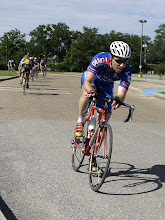Crank length from the cyclist perspective
I always find cycling analysis interesting. It doesn't matter if it's equipment, training, bike fit or anything else. It's most important to review the information and determine the perspective of the author. Take the information and dissect it so that you can gain a better understanding of the information on the surface but also consider it at a deeper level.
Every article or opinion has some sort of context. Often times, it focuses on a vary narrow aspect of the sport. You need to determine if the information is applicable to your riding style or interest. Also, you need to assess if the information has an equipment focus or rider focus. For example, the latest greatest aero frame may have the greatest technology. It may be bulletproof and invisible! But, if you can't fit on it, it's useless to you.
I just wanted to get this across before I start this entry. I'll let you know my perspective. This article is written with a focus on the athlete. It is not written from a perspective of a specific aspect of cycling. With this in mind, I think everything should be written with the athlete as the primary focus. Without a functional, effective athlete, a bicycle only leans against a wall.
It's my goal to turn bicycle riders into cyclists. Happy cyclists! For the athlete, crank length needs to be the same, regardless of the type of cycling that is occurring. Every bike you own should have the same crank length. Determining the right length is a factor of fit first and then passion. For example, if you are a track cyclist, your crank will be shorter due to the nature of the event. It will probably be shorter than your road crank if you didn't ride on the track. This crank length should be translated to your road, TT and MTB.
Why? As a cyclist, pedaling is about establishing a finely tuned series of muscle contractions that turn the cranks in a circle. The size of that circle is dependent on the length of the crank arm. If you have the same crank length of every bike, your brain is able to finely tune the movement pattern associated with one size circle. If you have multiple crank lengths, your brain needs to establish multiple movement patterns. If you are talented and have an excellent sense of movement, this will have a limited but real impact on you. If you have a limited ability to understand where your joints are in space and the speed/direction they are moving, having multiple cranks lengths can be a source of injury. Think about it from the brain's perspective.
Taken in perspective to event. I could quite possibly have three different crank lengths. Additionally, there's probably an "event based" piece of research to support each length. I could have 170's on my track bike. I'm 5'10". My track cranks might be shorter. (I'm not a track cyclist). My road bike could be 172.5's based on calculations or manufacturer suggestion. If I go MTB or Tri, I could be looking at 175's. From the brain's perspective, this is the equivalent of putting an efficient motor pattern in a blender.
Give your brain a chance to become great at one size circle. Purchase the same crank length for each of your bikes.


0 Comments:
Post a Comment
<< Home